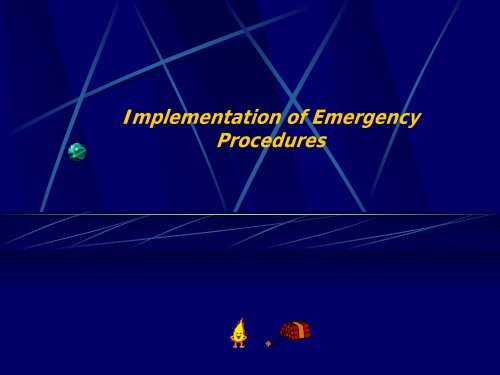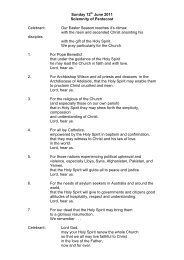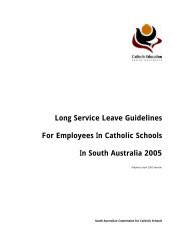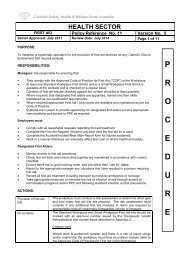Contribute to the implementation of Emergency Procedures
Contribute to the implementation of Emergency Procedures
Contribute to the implementation of Emergency Procedures
Create successful ePaper yourself
Turn your PDF publications into a flip-book with our unique Google optimized e-Paper software.
Implementation <strong>of</strong> <strong>Emergency</strong><br />
<strong>Procedures</strong>
<strong>Emergency</strong> procedures<br />
<strong>Emergency</strong> can be unexpected at any time and any where in a<br />
work place<br />
The initial response <strong>to</strong> any emergency is more effective if people<br />
know what <strong>to</strong> do.<br />
This also helps avoid irrational behavior<br />
There should be guideline and procedures <strong>to</strong> follow when an<br />
emergency occurs<br />
Staff should be trained and competent <strong>to</strong> perform <strong>the</strong> roles ei<strong>the</strong>r<br />
as directed by those in charge <strong>of</strong> <strong>the</strong> evacuation
RESPONSE TO EMERGENCIES<br />
Initial Response<br />
Emergencies affect people, property and equipment.<br />
It is highly desirable that <strong>the</strong> initial responses <strong>to</strong> any emergency be<br />
prepared by “people” ra<strong>the</strong>r than a individual.<br />
Action that may contribute <strong>to</strong> any emergency will depend on good<br />
management practices that will ensure adequate response <strong>to</strong> <strong>the</strong><br />
emergency and evacuation.
What is an emergency?<br />
An emergency is any event which arises internally<br />
or from an external source which may affect <strong>the</strong><br />
safety and well being <strong>of</strong> persons in a building or<br />
<strong>the</strong> community generally and calls for immediate<br />
response by <strong>the</strong> occupants.
Major types <strong>of</strong> emergencies are<br />
Bomb –<br />
Explosion effect, Structural Damage and consequence on people<br />
Fire –<br />
Building/structural/smoke damage/water damage<br />
Natural disaster –<br />
People/ Property/Personal surrounding areas<br />
Biological and Radiation –<br />
Health and safety <strong>of</strong> persons (Long or Short term)<br />
Gas leak –<br />
Minimize spread<br />
Flooding –<br />
Control and personal risk<br />
Person threat –<br />
Minimize personal danger
The <strong>Emergency</strong> Evacuation Plan<br />
Should Be:<br />
Simple<br />
Flexible<br />
Written<br />
Disseminated<br />
Tested<br />
Reviewed
<strong>Emergency</strong> Evacuation Plan<br />
What should we consider:<br />
• Escape routes<br />
• Exit<br />
• Assembly areas<br />
• Search pattern / areas<br />
• Special duties<br />
• Security - personnel<br />
• Type <strong>of</strong> facility
<strong>Emergency</strong> Evacuation Plan<br />
O<strong>the</strong>r fac<strong>to</strong>rs should we consider<br />
People with mobility, intellectual, visual, audi<strong>to</strong>ry or sensory<br />
impairment ei<strong>the</strong>r temporary or permanent who require assistance<br />
during any emergency response<br />
People with diverse cultural and linguists background<br />
People who are injured or suffer from an illness<br />
given<br />
People who are not able <strong>to</strong> comprehend <strong>the</strong> instruction<br />
Pregnant Women - Babies and Children
<strong>Emergency</strong> Evacuation Plan<br />
Communications<br />
Response and cooperation with Emergencies services and<br />
environmental agencies<br />
Response and cooperation with Government agencies<br />
Response and cooperation with Community Groups<br />
Response and cooperation with Service Groups
Planning Initial Response <strong>Procedures</strong><br />
When planning emergency procedures you should<br />
determine what action would be necessary<br />
• Identify <strong>the</strong> need <strong>to</strong> initiate an emergency response<br />
• Protect employees, cus<strong>to</strong>mers/ visi<strong>to</strong>rs, contrac<strong>to</strong>rs<br />
• Protect equipment, records and o<strong>the</strong>r assets<br />
• Res<strong>to</strong>re <strong>the</strong> facility <strong>to</strong> operational function<br />
• Identifying outside assistance and welfare needs<br />
• Lines <strong>of</strong> communications<br />
There may be a need <strong>to</strong> consider specific procedures for<br />
situation such as robbery, bomb threats. serve s<strong>to</strong>rm
Actions <strong>to</strong> be taken during emergencies<br />
The order in which action is <strong>to</strong> be taken would depend on <strong>the</strong> type <strong>of</strong><br />
emergency<br />
The location <strong>of</strong> assembly point (including <strong>the</strong> alternate assembly point)<br />
will depend on <strong>the</strong> emergency<br />
The order will also depend on <strong>the</strong> instructions <strong>of</strong> <strong>the</strong> person in charge <strong>of</strong><br />
<strong>the</strong> evacuation<br />
To evacuate or not <strong>to</strong> evacuate may depend on guidance from<br />
emergency services<br />
Is partial evacuation an option depending on <strong>the</strong> type <strong>of</strong> people being<br />
evacuated also <strong>the</strong> building which is in use at time <strong>of</strong> <strong>the</strong> emergency
Setting up <strong>Emergency</strong> Evacuation Plans<br />
In developing an emergency plan you may need <strong>to</strong><br />
consider<br />
The appropriate escape routes<br />
The appropriate assembly points<br />
The appropriate <strong>Emergency</strong> Control Organization<br />
Raising <strong>the</strong> Alarm and notifying people<br />
The strategy for account for everyone<br />
Mobility impaired person and children<br />
<strong>Emergency</strong> Services access and any special requirements<br />
Movement <strong>of</strong> traffic in and out <strong>of</strong> <strong>the</strong> building/site<br />
The order <strong>to</strong> evacuation a building / floor / site<br />
Security arrangements and restricted entry
Identify <strong>the</strong> Resources Required for Immediate<br />
Response<br />
<strong>Emergency</strong> Control Organization<br />
Evacuation alarms<br />
Communication equipment<br />
Fire Fighting Equipment (including extinguishers – Hose Reels)<br />
Torches<br />
Designated persons identifying equipment e.g. colored hats, caps and<br />
vests<br />
First Aid Equipment<br />
Evacuation equipment for disabled persons
Identify <strong>the</strong> Resources Required for Immediate<br />
Response<br />
Site plans <strong>of</strong> services information<br />
Hazardous substance information<br />
Good communication systems<br />
How <strong>to</strong> operate or raise <strong>the</strong> alarm<br />
Awareness <strong>of</strong> <strong>the</strong> Signals/Alarm System<br />
Staff should know how <strong>to</strong> communicate with <strong>the</strong> ECO<br />
Designated persons for specific tasked<br />
Barriers, bollards and signs
Communication codes<br />
The color codes for various Emergencies<br />
Fire and Smoke – RED<br />
Building Evacuation – ORANGE<br />
Internal emergency –YELLOW<br />
Medical <strong>Emergency</strong> – BLUE<br />
External <strong>Emergency</strong> – Brown<br />
Bomb Threat – Purple<br />
Personal Threat – Black<br />
Australian Standard AS 3745
Setting up a <strong>Emergency</strong> <strong>Procedures</strong> Inspection<br />
Program<br />
Every organization should have a <strong>Emergency</strong> <strong>Procedures</strong><br />
Inspection program in place<br />
Issues <strong>to</strong> consider are<br />
Egress routes are unobstructed<br />
Hazard Analysis and Register are current<br />
Safety check on equipment and function properly<br />
Safety isolation information for all services is available<br />
Routine Safety inspection are carried out and recorded
Fac<strong>to</strong>rs that can lead <strong>to</strong> unnecessary danger<br />
Fire exit doors locked<br />
Poor housekeeping<br />
No emergency evacuation plan<br />
No trained emergency wardens personal<br />
Average number <strong>of</strong> people in each area<br />
Windows jammed & bars<br />
Highly flammable substances<br />
s<strong>to</strong>red in workplace.<br />
No fire extinguishers<br />
Smoking allowed in workplace
Identify Training Needs<br />
Training needs analyses<br />
Responsibility for training<br />
Who requires Training<br />
When training is <strong>to</strong> be conducted<br />
Types <strong>of</strong> training<br />
Staff induction<br />
Contrac<strong>to</strong>rs<br />
Casual Staff<br />
Shift staff<br />
<strong>Emergency</strong> control organization<br />
Special personnel<br />
Appropriate Training Providers
Evacuation Debriefing
Evacuation Debriefing Process<br />
People who will be required for a debriefing<br />
after each evacuation<br />
<strong>Emergency</strong> Control organization (all or part)<br />
People with overall evacuation control or a person<br />
delegated with that responsibility.<br />
Security Personnel<br />
Traffic Controllers<br />
Counselling/support for personnel involved and/or<br />
affected by <strong>the</strong> emergency
Evacuation Debriefing Process<br />
People who may be required for a debriefing<br />
after each evacuation<br />
<strong>Emergency</strong> Services Personnel.<br />
Police,<br />
Ambulance Officers<br />
Government authorities<br />
Hazchem specialist<br />
Counselling and support support services
Participation in <strong>the</strong> Debriefing, Moni<strong>to</strong>ring and<br />
Addressing Deficiencies<br />
Results <strong>of</strong> debriefing <strong>of</strong> any emergency evacuation are<br />
documented promptly and appropriately reported <strong>to</strong><br />
managers and key personnel including <strong>the</strong> Stakeholders<br />
Implement a follow-up plan for continuous improvement<br />
including any recommendations in areas identified for<br />
correction action<br />
All recommendations made be reviewed and submitted for<br />
approval and signed <strong>of</strong>f by appropriate person<br />
Issue revised Documentation <strong>Procedures</strong>/Plans<br />
(including ECO personal where applicable )
Building Code Of Australia<br />
Lets Look at <strong>the</strong> implication <strong>of</strong> <strong>the</strong> Building Code Of<br />
Australia in regard <strong>to</strong> <strong>Emergency</strong> <strong>Procedures</strong>
















